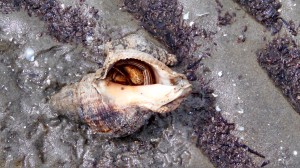As I mentioned in my last post, ocean acidification is likely to cause problems for hermit crabs both because the calcium carbonate used by snails to construct shells which are, in turn, used by hermits will be less available and because hermits exhibit less movement and environmental awareness as pH drops. A variety of aquatic animals are likely to have similar problems as climate change progresses.
In my reading this week, I learned that other developments, some connected to climate change, will also create problems for hermit crabs. As water gets warmer, it is less able to hold dissolved oxygen, which means that there is less available for aquatic organisms to use. Global warming is predicted to reduce dissolved oxygen levels around the world, and then this may be combined with increased nutrient levels from agricultural and other run-off, so that reduced oxygen events become even more intense. When Riedel et al. (2012) tested the responses of several groups of benthic fauna (such as worms, molluscs, and sea urchins) to reduced or non-existent oxygen levels, they found that hermit crabs, although being among the most tolerant of decapods, were still quite sensitive to reduced oxygen levels. The crabs attempted to find refuges with more oxygen and often died before dissolved oxygen was completely gone. Since we can expect warmer seas and more aquatic events with severely reduced oxygen, we can also expect more sensitive species, such as sea urchins and hermit crabs, to fare badly during these events. Why does this matter? Well, we may find that biodiversity is severely reduced in some areas as the more sensitive species disappear, and that can make the entire system less likely to recover from disturbances.
Although I was initially surprised to learn it, some hermit crab populations are also at risk from invasive terrestrial species. The yellow crazy ant (Anoplolepis gracilipes) is an invasive species throughout the tropics and subtropics which consumes carrion as part of its diet and can spray formic acid in defense and aggression. On islands in Tokelau where yellow crazy ants had established colonies, hermit crab densities were lower and the ants were able to exclude the crabs from specific food resources by spraying their heads with formic acid (McNatty et al. 2009). The crabs were less of a presence in island interiors and fed lower down the food chain when the ants were present. How could this change island ecology? Hermit crabs are important aerators of marsh soil and have an impact on plant distribution and abundance, so we could find that plant communities are changing when hermit crabs are less common. And although it wasn’t documented in McNatty et al.’s study, O’Dowd et al. (2003) found that these ants had extirpated red land crab populations on Christmas Island.
Our own marine activities have also created some problems for hermit crab species. Although they may not look like it, king crabs are hermits, and Bristol Bay, Alaska witnessed a red king crab population collapse in the early 1980s due to pot fishing and trawling for ground fish (Dew & McConnaughey 2005). The stock had still not recovered 20 years later because crabs moving from nursery areas to breeding areas had to traverse ‘cod alley’ where they were often scooped up by trawlers and the crab harvest itself targeted just males, leaving a very skewed sex ratio.
Although hermit crabs may seem pretty durable and present in so many habitats, some species, such as coconut and king crabs, have already experienced population declines (Wang et al. 2007), and the outlook for the future suggests that more are likely to do so as our oceans acidify and contain less dissolved oxygen. And the challenges of climate change and invasive species are likely to affect a wide variety of crustaceans, so it makes sense to start thinking about ways to support these populations. In my final post of the month, I’ll take a look at crab conservation efforts and hopefully dig up a few ways for us to get involved in all of that.
Works cited:
Dew, CB and RA McConnaughey. 2005. Did trawling on the brood stock contribute to the collapse of Alaska’s king crab? Ecological Applications 15: 919-941.
McNatty, A, Abbott, KL, and PJ Lester. 2012. Invasive ants compete with and modify the trophic ecology of hermit crabs on tropical islands. Oecologia 160: 187-194.
O’Dowd, DJ, Green, PT, and PS Lake. 2003. Invasional ‘meltdown’ on an oceanic island. Ecology Letters 6: 812-817.
Riedel, B, Zuschin, M, and M Stachowitsch. 2012. Tolerance of benthic macrofauna to hypoxia and anoxia in shallow coastal seas: a realistic scenario. Marine Ecology Progress Series 458: 39-52.
Wang, F-L, Hsieh, H-L, and C-P Chen. 2007. Larval growth of the coconut crab Birgus latro with a discussion on the development mode of terrestrial hermit crabs. Journal of Crustacean Biology 27: 616-625.

